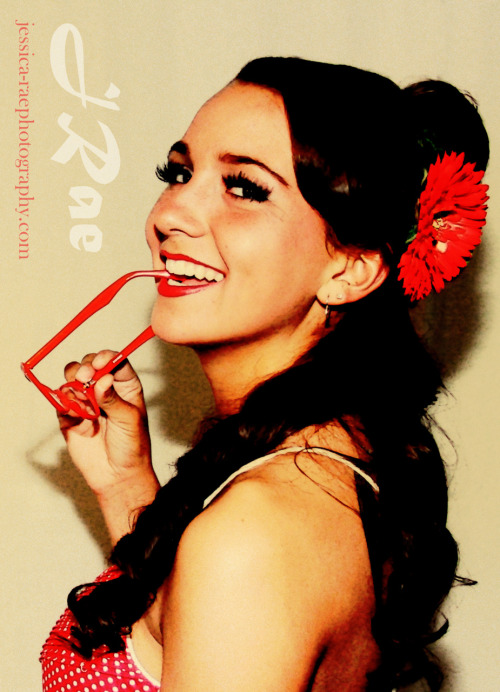LEE FILTERS - to join the list of people waiting for theirs from back order..... or to settle for something else?? Disclaimer: I am not being paid by ANYONE to put out this mini review.
Most people want Lee Filters, but get frustrated because they're on back order. You can add your name to the list of people waiting for theirs to come. I have managed to get my hands on their 3, 6, 9 ND set as well as their 3, 6, 9 GND set, the square full red, and the sunset set (half red, half orange, and half yellow.) I also have a Tamron half red and a Tamron half blue. In addition, I have a whole bunch of home-made filters, but that's another post worth of information.
While using a filter, I can indeed produce a SOOC image that is (from my perspective) better than the one I could produce with layers in photoshop with no filter use. I also find that to properly use LEE filters, one needs to know how to use the white balance on their camera to better amplify the effect of the filters (or you can do it in photoshop, but that doesn't typically turn out as nice). What I'm saying is that when you use filters, you're better off NOT shooting on AWB.
Lee is the top-of-the-line company, but if you don't want to wait or don't want to pay that much (remember that a British Pound is currently $1.55) here are some you could substitute as kits: HiTech, SinghRay, Tamron. Don't substitute Hoya or Cokin. Honestly I think my Hoya is best used as a Frisbee. Cokin only produces graduated color filters, and there is a big difference between that and a graduated gray filter. I can't speak about their quality, as I don't use their products.
Things I like about LEE: they are very compatible with my light meter. Some others I have borrowed have done wacky things to the light meter that make it annoying to shoot - you basically have to guess and check on exposure until you get a feel for whether it sits at +2 or -2.
Like all filters, Lee's products are not scratch proof. However, they come in a great cloth case and cardboard box. You can buy their filter pouch for like $7 and that's well worth the price as well. The square ND filters are best kept in the cardboard box. Don't screw up that box!
I don't have much negative to say about the filters except I wish they weren't so hard to obtain.
I will also say that the LEE grad colors out-perform my Tamron grad filters. However, if I tweek my white balance, I can achieve the same result with the Tamron product as I could with the Lee's.
About my LEE Holder
It is larger than other companies' holders, which is very convenient. It holds larger filters (4"x6"), and is great construction. I love the quick release! I can take it off the 77mm (filter size) ring and put it on the 82mm easily and quickly. It's also drop proof by the way.
I wish the attachment (the part that the quick release releases from) screwed onto the lens like either a lens cover or filter does. It's kind of a pain in the neck to attach to my lens quite honestly. It's so much of a pain that I wish I could just leave it permanently on my lens - but if I leave it on and release the holder, I have to take it off to use a lens hood or a filter. It's more than a little annoying, and I have seen better schematics on my friends' cameras.
I wish it had a slot for three filters instead of two (they make a part you can add on, but it's always sold out so if you want to use three filters and have one stay tuned as I am making something and will blog about it once it works the way I need). I find myself sometimes hoping I could use 2 grad colors and an ND but I can't because there are not enough slots to hold them. If someone can find me a 3 slot LEE holder I'd sell my 2 slot holder.
I wish there were a way to use the LEE holder with a circular polarizer on the lens. They sell a "circular polarizer front mount thread" but is back ordered (of course.) I am going to attempt to make one of those as well from a step-up ring.
I BLOG ABOUT PHOTOGRAPHY AND ALL THE SUBJECTS RELATED. SOMETIMES I POST MY PICTURES, SOMETIMES I TALK ABOUT EDITING PICTURES, SOMETIMES I TALK ABOUT CAMERAS, OR MAKING WEBSITES; SOMETIMES I JUST TELL JOKES.
This site is NOPIN - No pinning on Pinterest.
Wednesday, February 29, 2012
Lee Filters: A Short Review
Labels:
Cokin filters,
HiTech filters,
Hoya filters,
Lee Filters,
Lee filters review,
Lee holder,
limited editing,
limited photoshop,
post-processing,
SinghRay filters,
straight out of camera
Starting Photo Sales: What to Pay for and What to Not Pay For
Are you debating whether or not to start selling your photos professionally but become flabbergasted by how much it costs to do this? Here's some completely non-inclusive advice about what to pay for and what to not pay for.
PAY FOR:
1) Web hosting and domain. Personally I use because their customer service is great (it's outsourced but they have online chat and fix things immediately.) and they are pretty cheap. People trust sites that have a .com address with its own domain over anything else. You have more control over what you can post where, and more control over raising your web ratings. You even have more control over who can see your work - I don't allow mine to be pinned on Pinterest, and I can track who right click / downloads my images.
2) A web site creator (a human) or an HTML / CSS for dummies book / or a class - I took a class on Dreamweaver at the community college. Great investment!
3) A lawyer and an accountant. Nuf said. The lawyer is even more important if you photograph people - I also invested in a Business Law course and a Small Business Owners class at the college.
4) Insurance.
5) Backup for your images. Harddrive crashes are your worst enemy. I would recommend getting a or other form of backup for your precious photos.
DON'T PAY FOR:
1) A payment card program / print sales site separate from yours - I use to sell prints online instead of because it's free! It's linked to my paypal account. There are also apps out there that you can use to sell your prints off your site but they cost money. Some HTML geniuses can figure out how to do it - but I'm not one lol.
2) A business phone - I use as a number for my business so I don't have to give out my cell number - for the same reason - It's free. I can organize calls into folders like Gmail. I can easily block numbers, and I can even record calls!
3) An online organizer program to track clients / sales / etc. I use Microsoft Access to track who ordered what when - what serial number print was sold to who when - etc. No need to pay extra money for something online.
4) A smartphone. (Unless you want to or do phone-ography or something.) Lots of people think they NEED a smart phone for their business. My answer is "why?" Clients can pay by credit card via Storenvy, and I don't need internet to finish a transaction with them. My portfolio is in my briefcase on shoots and not on my phone. I suppose some might find a reason they'll NEED a smart phone, but I don't lol.
5) Entry into contests!! Sometimes I joke about how I've never won a contest, but the main reason for that is that I rarely enter. Why? Well.... why the hell would I see it as a good business practice to PAY SOMEONE to consider my art? If my art is good enough to be seen in that way they should be PAYING ME to use it. Of course there are a few exceptions (a very few), but for the most part - if you're a pro photographer entry fees into contests are a waste!
PAY FOR:
1) Web hosting and domain. Personally I use because their customer service is great (it's outsourced but they have online chat and fix things immediately.) and they are pretty cheap. People trust sites that have a .com address with its own domain over anything else. You have more control over what you can post where, and more control over raising your web ratings. You even have more control over who can see your work - I don't allow mine to be pinned on Pinterest, and I can track who right click / downloads my images.
2) A web site creator (a human) or an HTML / CSS for dummies book / or a class - I took a class on Dreamweaver at the community college. Great investment!
3) A lawyer and an accountant. Nuf said. The lawyer is even more important if you photograph people - I also invested in a Business Law course and a Small Business Owners class at the college.
4) Insurance.
5) Backup for your images. Harddrive crashes are your worst enemy. I would recommend getting a or other form of backup for your precious photos.
DON'T PAY FOR:
1) A payment card program / print sales site separate from yours - I use to sell prints online instead of because it's free! It's linked to my paypal account. There are also apps out there that you can use to sell your prints off your site but they cost money. Some HTML geniuses can figure out how to do it - but I'm not one lol.
2) A business phone - I use as a number for my business so I don't have to give out my cell number - for the same reason - It's free. I can organize calls into folders like Gmail. I can easily block numbers, and I can even record calls!
3) An online organizer program to track clients / sales / etc. I use Microsoft Access to track who ordered what when - what serial number print was sold to who when - etc. No need to pay extra money for something online.
4) A smartphone. (Unless you want to or do phone-ography or something.) Lots of people think they NEED a smart phone for their business. My answer is "why?" Clients can pay by credit card via Storenvy, and I don't need internet to finish a transaction with them. My portfolio is in my briefcase on shoots and not on my phone. I suppose some might find a reason they'll NEED a smart phone, but I don't lol.
5) Entry into contests!! Sometimes I joke about how I've never won a contest, but the main reason for that is that I rarely enter. Why? Well.... why the hell would I see it as a good business practice to PAY SOMEONE to consider my art? If my art is good enough to be seen in that way they should be PAYING ME to use it. Of course there are a few exceptions (a very few), but for the most part - if you're a pro photographer entry fees into contests are a waste!
Travel Report: London, United Kingdom
More clever, less PC title: “I Took My Canon To London And I Shot The Place Up”
Length of Stay: 3 days - January 2012
Things I Wish I Had: A blue/gold polarizer filter, more money, and an invisibility cloak
I arrived to London Heathrow airport at 7:30am and found my way onto the subway (or the Underground if you’re in London) on my way to my hotel (or in a general eastward direction). With my backpack, my rolling suitcase, and my camera bag in my hands and my American money, a credit card and a shitty map in my pocket, I arrived at Green Park – it was the only stop I could identify on my map. It was astounding to me how many people on that subway did not speak English. Luckily the guy in the information booth was a British national. “You a lost American?” he said. I kind of chuckled and affirmed his question. I told him the address I needed to get to, and he told me to get on the Victoria train for one stop (to Victoria station). It was simple enough.
When I walked outside it was pouring rain… and the wind was probably moving at 100 mph. Truly, this was a new definition to “raining sideways.” I had a ticket to the Tower of London that was only good for that day (the 4th of Jan 2012) so I dug my umbrella out of my bag hoping it would protect me from the rain when it wasn’t blowing inside-out from the wind. The British man had circled where I was on my map and drawn me a line to where I was going. One step two step.
I used to complain about whoever named the city streets in San Diego. I will never do that again. Most of London’s streets were literally only about a block long until they got a new name. It made me wonder how they didn’t run out of names – at least in San Diego we have 1st Street to whatever the highest number is…. And A Street to whatever the highest letter is going the other way. Here in London we had a million different names for the same street going the same direction. If a street curved it would get renamed sometimes, but not other times.
The good thing about the rain, though, was that it made for some beautiful clouds (when I wasn’t freezing cold) if I could fight through being cold. My hands don’t work well in the cold because of a nerve condition, so I had to use camera on tripod and a remote even for the shortest exposures. Aw well. The landmark I used to turn onto the street of my hotel was Coroner’s Court, which had a taxi parking depot and an old red payphone (which they still use).
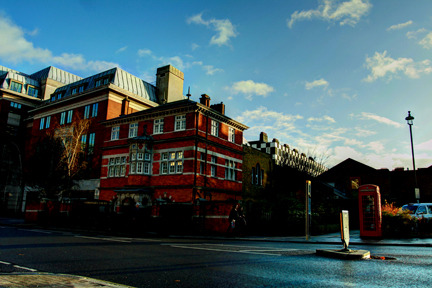
I got to the hotel (which by the way was located on a SQUARE street around a park) at around noon after getting lost a few times. I was totally drenched, and so were my bags. I checked my suitcase and backpack into the hotel and grabbed my camera, off to the Tower of London again via the subway. This time the stop was literally right outside the London Tower, so I was happy about that. It was still pouring though, so I decided to wait a few minutes for the wind to settle down again before walking to the entrance. Luckily it was mostly an inside venture. The Tower of London is a castle from the Medieval Era and a great dose of London’s history. There were a lot of people inside, so I wasn’t able to capture a really good photo of the inside of the castle. It was about what you would expect a castle to be, though. There were several employees that acted and dressed like the inhabitants of the castle (for the children, of which I am obviously one). There was a little bit of literature about the tower that housed prisoners, but it was a hair sugar-coated, presumably because the Tower of London was very child-friendly. They did show the rack and several other devices used for torturing the prisoners. The sky outside the Tower was a very photogenic bright white color, but right as I was getting ready to leave, the clouds got even thicker and I was able to get this fog shot:
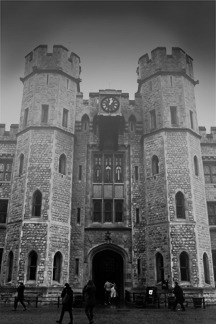
Later in my trip, I went to the Clink Prison Museum, where I learned the version of the history that gave me nightmares, and I’m wondering why I’ve never read about Britain in the 15th and 16th Centuries in any US history class I’ve ever taken. It is our history too, as this was occurring right up until our country’s founding, and the museum even gave the perspective that many went to the New World to escape to a land of promise (and then in parentheses: and some were condemned to live a life in the southern land of Australia). I learned about Bloody Mary and Elizabeth and the fight for the throne between the Protestants and Catholics. People could be imprisoned and tortured in Clink for things as simple as owing money, and people were supposed to pay for their stay there (as in: they had to pay rent to the prison that was torturing them). If a woman were imprisoned in Clink Prison, her children were forced to go live there with her. Prisoners could leave the Clink if they wanted, but they had to carry around the ball and chain with them outside. I seriously have nightmares now, but it was good to find some true and honest history.
In London it started to get dark by 3:30, and the clouds started to change color at around 2:45. Here’s a shot of the entrance to the Church of England branch looking up at the sky.
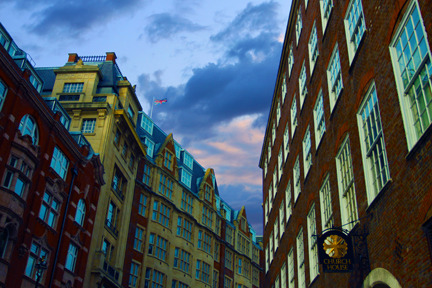
I was expecting my low-budget London motel to be similar to a low-budget American hotel or Motel 6. Wrong. The Wellington Hotel only cost me $77 a night (so probably about 50 Pounds), and it had a twin bed, a wall locker, a desk, a sink, and a TV on the desk. There was a shared bathroom for the whole floor. It reminded me a lot of a military barracks for some reason, and I actually went back outside at one point to make sure it said “hotel” and not “over-priced hostel.” Oh yea I forgot to mention the heater didn’t work, which was a big deal considering the winter temperatures in London and my nerve condition. Although the room was small, the bed was comfortable and the staff was helpful. They even gave me a more detailed map of London and a subway map.
London has more coffee shops than any American town I’ve ever been to, and the best part about that is this: I saw 49 different coffee shops before I saw a single Starbucks. That’s reason enough for me to move to England, as Starbucks has always tasted burned to me. I tried a lot of coffee shops, but my favorite was definitely Caffe Nero. I also found the food to be interesting. It took me a while to find a place that served Fish and Chips, which I wanted to have since I was in the UK for heaven’s sake. I suppose I walked down a sort of international food street as I passed upscale Italian, Spanish, French, Greek, Mediterranean, and multiple coffee places before there was a Fish and Chips place at the end of the street. I snickered when I saw the “American food” sign and the restaurant was a Subway. At least it wasn’t McDonald’s.
In my second day in London, I found myself at Westminster Abbey and Big Ben. I walked around the complex and noticed two protests taking place in London streets. The first was right across from Big Ben – people were camped there protesting to get troops out of Afghanistan. Suddenly I felt like I was home (snicker.) The United States seems to take a lot of criticism for being the war-monger nation in the West, the imperialist invaders of the modern age (because of the numerous bases on foreign soil), so it was interesting to me to see that our allies also got similar uproars in their homes. I asked one of the law enforcement officers how long they’d been out there and whether or not it was legal for them to sleep in the streets, as they were sleeping in tents. He said it was legal for now and that they were in the process of passing a law prohibiting camping in the streets. I then learned that those particular protesters had been there for a few years.
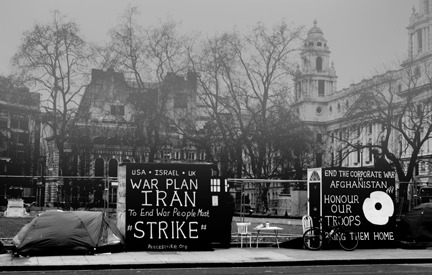
Down the street a little further it was not an occupy-style sleep-in protest, but a gathering of African Brits (it’s politically-correct to refer to people as black or white in the UK) protesting the UK’s presence in both Iraq and Libya but neglect of presence in Congo.
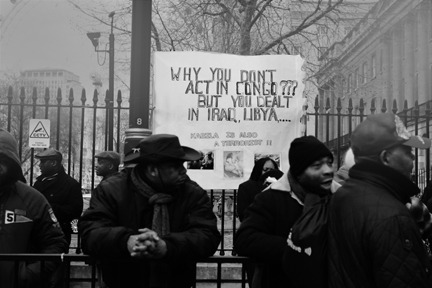
More than the protests, what I noticed was the calm demeanor of the law enforcement officers – and their acknowledgement that “everyone has a right to protest” and protection of their citizens’ rights. One of the police officers protecting the Congo protestors (a white guy) had tears in his eyes and asked me to show him my photos, clarifying that it was legal to take them but he just wanted to see them. My question of the legality alerted him that I was not British, and when he found out I was an American, he asked me about the Occupy protests. Apparently the gassing that took place in Oakland did not make international news (or at least not British news). He did not know that the police men used nerve gas on US citizens protesting in the streets and was appalled that it happened to an elderly lady and a veteran. British cops do not carry firearms or any sort of stick like US cops. They don’t wear uniforms or display rank – they wear bright yellow vests. I saw some of them riding in cars, and some riding horses. It seems that unlike the US cops that I have now acquired a mistrust toward, British cops really do serve and protect their people. However it seems to be relatively recent that London has gotten over a sort of problem with racism according to the news, but I’m not sure how credible that is as racism is easy to claim for every single inequity.
Down the street from the Congo protest was a memorial to the Women of World War II, displayed in the middle of the street so that everyone had to drive past it. It makes me want to go pick up a British history textbook and read about World War II from their perspective. The only perspective I’ve ever heard is the American side, and then I got the other countries when it was relevant.
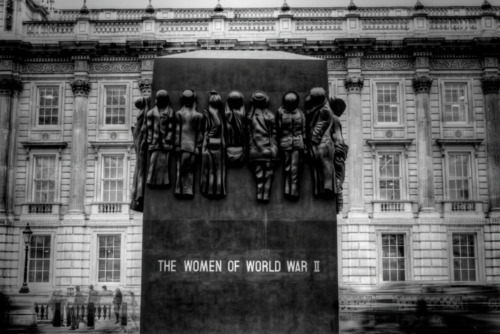
The memorial was inspired by the woman spy, Eileen Nearne, who sadly is recently deceased. The poor lady didn’t have any living relatives and died alone, but she had an exciting life. She inspires me because she was a woman linguist. She spoke fluent French and was sent by the British forces to work as a secret radio operator. She was caught using her radio at age 23, imprisoned, and tortured. Despite their abuse and torture, she wouldn’t relinquish her story of being a little shop girl who had no knowledge of secret war tactics. She was released by the French but later captured by the Germans. She escaped the internment camp, but was captured again. She was then able to use her language skills to convince them she was innocent and she was released. This is a detailed British article about her life and death if you want to read more: http://www.dailymail.co.uk/news/article-1311699/Tragedy-WWII-spy-Eileen-Nearne-escaped-Gestapo-died-alone.html
Every 50 meters inside Westminster Abbey houses a sign “no photography, please” and given the video cameras around in the area, monitoring peoples’ compliance with the law, I didn’t chance that one. I even went to the press office and asked permission to take photos, and they said it was not possible. They offered to sell me photos though. Big Ben was not open to the public, and there were about six cops outside. However, that didn’t stop me from taking photos outside either of the buildings and inside Westminster Abbey where there was not a sign with video surveillance.
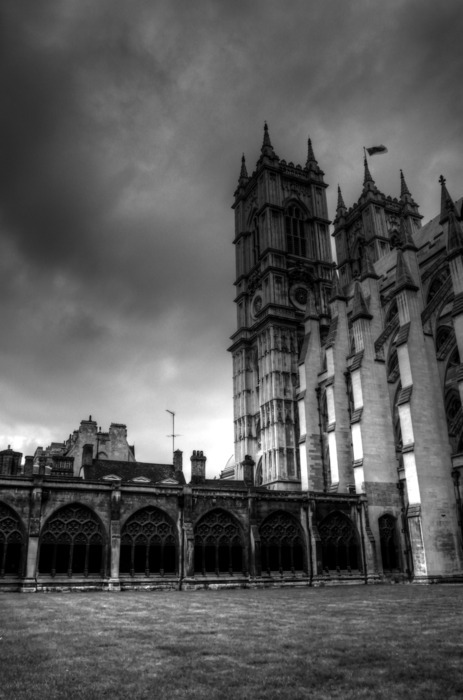
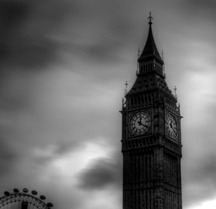
I decided I wanted to hear what was on British news. I was actually surprised to hear what they had to say about the US Iowa caucuses. They were very interested in them, and it seems that Britain is in favor of getting Obama out of office – which surprises me from a socialist country. I suppose that has to do with the state of the US economy and how much the world relies on the dollar (by the way, one pound is worth $1.55). I was very interested to hear the statement, about Romney, “Watch that man, as he could soon become the most powerful man in the world. He could become the leader of the only world superpower.” First of all, it never dawned on me to think that the US president could be the “most powerful man in the world” but I suppose that could be an accurate statement given how stout the US military is, and how much we as a country like to flex those muscles – and how much influence our currency has on the rest of the world. I was also surprised to hear the US referred to as “the only” superpower. Honestly, I consider the UK to be a superpower along with Japan, China, and the EU. I’m surprised the UK doesn’t regard itself as such. So, UK… if someone attacked you, what would happen? See… you’re a superpower.
On a closing note, it was nice to see that the British, like Americans, were a very patriotic group of people. Every block had a flag flying high on a building top. Americans are often criticized for their “worship” of their colors, but we don’t fly as many flags as the British (at least in London) seem to. Go for it, UK! Be proud of what your flag stands for! (Side note: as a general rule, I HAAAATTEE selective color in photos, but every once in a while I find myself breaking even my own rules about photography when appropriate.)
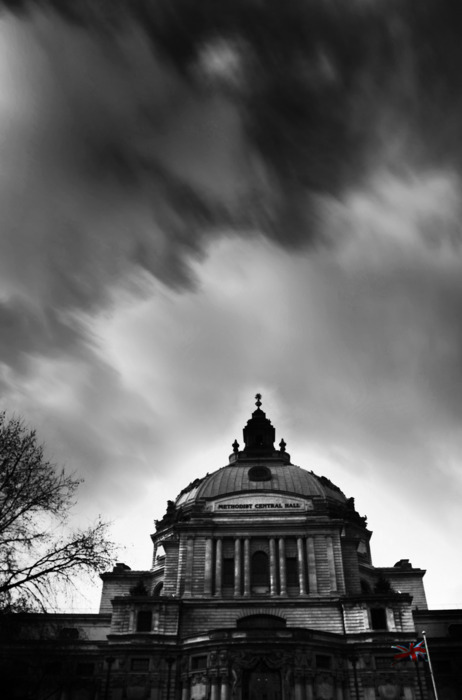
What Should I Wear to my Photoshoot?
Jessica Rae Photography requires a pre-session consultation to go over this question face-to-face, but there are certain rules about what to wear and what not to wear that are universal.
Photographers can use many pieces of software to create a work of art that shows you at your best - but you have to follow the rules to make sure this happens! Most of the time, if a client decides they don’t like a photo, it’s because of confusion. The photographer needs to explain what the client’s job is, and the client needs to explain what they expect from the photographer.
Retouching is an every-day process for many photographers, but there are limits to what retouching can accomplish. Sometimes it can take longer to do for different patterns of clothing or different styles of hair, which would cause the price to go up. Typically if the client wants a photo done in a wardrobe or style that is not in compliance with what the photographer outlined, the photographer will change more or even void the refund clause.
The guidelines in this post are by no means all-inclusive, but some guidelines are below:
Clothing
- TOPS: A solid color top that is not revealing is best - avoid obvious textures or fabrics that shine (avoid sequins, velvet, glittery clothing etc.) In most cases plain cotton or polyester blended fabrics work out best.
- Sleeveless tops are a good item to avoid if you are concerned about your upper arms and shoulders looking large or if you are concerned about cellulite or arm hair.
- Avoid very bright or bold colors if you are looking to have a great photograph of your face.
- Generally, shirts that show the midriff or belly are not a good idea for most women - some are concerned about stretch marks or imperfections, but almost all will decide they do not like it when they are a few years older. Jessica Rae Photography tries to generate photographs that are loved for lifetimes.
- BOTTOMS: Dark with dark stitching or a solid color - non-textured pant is best if you intend to have retouching done to your photography.
- Solid colored not-shimmery mid-thigh length or longer skirts are preferable.
- If you are concerned about looking slimmer in your photo, you should wear black clothing that is relatively form-fitting but not skin tight.
- Short shorts and short skirts - these items limit your posing options and can be an issue to some people who are concerned about the toning of their legs, stubbly leg hair, or cellulite.
Makeup
- Avoid glitter. When glitter is photographed, it tends to looks like white dust spots on the camera instead of shiny makeup. In other words, it looks bad on film.
- Wear makeup that you would wear in your everyday life. If you change what you look like, you might end up with a photograph you dislike simply because it doesn’t look like you. Your parents might not like it for the same reason.
- Typically, the simpler the better is the rule for glamour shots.
Shoes
- Unless you want full-length shots every time it’s not necessary to go buy shoes for the photo shoot. Keep in mind that full-length also limits your posing and greatly limits the photographer’s ability to hide features of your body you don’t like by not putting them in the frame.
- The photographer will often like to do informal attire shots without shoes, but you can keep your shoes on if that bothers you.
Hair
- Wear your hair however is natural for you, but you need to make sure it is neat.
Should I Become a Professional Photographer?
Starting out as a professional photographer is exciting! Chances are, if you are considering the answer to this question, you enjoy taking pictures. However, there is a lot more to being a professional photographer than simply liking the work. This blog post will (hopefully) help you realistically answer that question before you start a business. Some of the information in here is from my own experiences, and some is from the experience of other photographers I have had the pleasure of meeting or working with. Either way, this post is full of solid points that you should consider.
Do you know how to make your business successful? I was lucky because I have a parent who is self-employed, so I knew basically how to run a business before I made one for myself. There is a lot of extra work that goes into a small business that people don’t even realize: paperwork, budgets, even more complicated taxes, lots of time and money spent on advertising, extra bank accounts, extra stress on your credit score, more chances to lose it all unless you set up everything correctly. (More information about all of these areas is discussed in the below paragraphs).
Being a pro photographer does not necessarily mean that you can make your own hours. Most of the time, photographers work whenever the client is NOT working. This means weekends, evenings, federal holidays, etc. You need to be prepared to accept this as a reality if you want to be a professional photographer. You cannot simply set your own hours and expect the client to get off work to get photographs taken by you. Moreover, whenever you are not shooting clients you will be spending “normal working hours” advertising, networking, budgeting, editing, blogging, managing the website, and whatever other chores need to get done. In all reality photographers do not get days off, nor do they usually get sick days.
Spending money on additional camera gear and software for your computer is NOT optional. It is necessary. However, you don't need to buy EVERY upgrade. If you are going to be a professional photographer, you should be able to buy all the gear you need (or already have it, or have friends from whom you can borrow it). You should have at least two camera bodies, two memory cards with sufficient space, at least 5 batteries for each camera, two battery chargers, flash kits and filters, and necessary lenses to make your art come to life. I would also recommend having a separate computer for your photography separate from your daily use computer. If you intend to sell prints, you will need a professional-grade printer. I started out with a lot of camera gear because photography was a hobby of mine for a long time, and I still spent about $12,000 on expenses related to my business the first year. The other side of this is that you should KNOW all your gear inside and out. This means that you don't need to upgrade your camera until the camera you are using does not suit your needs anymore. The same goes for software. You don't necessarily need to buy every upgrade to Lightroom or Photoshop, but you should HAVE the necessary software if you are going to be a professional photographer.
You will need to formulate solid contracts, and that will mean you must get help doing so. Law suits are becoming more common in today’s society (at least here in the United States), and it would be unrealistic and irresponsible of you as a business owner to operate without taking all legal precautions to protect yourself. Draft a contract about your services - I have one for weddings and one for everything else. Then spend the money to have an attorney look at your contract and help you make sure it will hold up in court. I would also recommend taking an introductory class on business law. If your client has not signed a contract, DO NOT TAKE PICTURES.
True story: I had a client a while back who wanted some photographs taken for his own business - he is a real estate agent. He and I got along well in the beginning, but he was very reluctant to sign my contract. I asked him why, and he said that he didn’t like bringing the law into his business transactions. Eventually I did get him to sign it. I took his photos in my studio, and sent him some proofs of which I was very proud. They looked like most real estate agents’ pictures. When he saw them he got really hostile, said they looked like [trash] and thought I was lying about my credentials. He told me he wanted a refund and the rest of his prints as a penalty for my bad work or else he would sue me for the amount I charged him plus legal fees. It gets better: he had asked me to use software to make his face skinnier, which took me hours. He agreed to pay the extra $200 I charged for that, but he wanted that money as well. After looking online I saw that he had cropped my proofs so that my name was not visible, severely altered the saturation to make his face look yellow, and then put it on his website.
You might get a similar situation one day and must decide what to do about it. My solution worked out well for me, but I knew about the law enough to know where to find answers I was looking for. If you want to know more about this, I’d be happy to talk about it with you. I use this book for my business law purposes, and I highly recommend it for any businessman, photographer or otherwise: 

The client will not like the same photographs that you like. If you can’t take someone saying “Oh I don’t like the way my smile is in that one” or “eew I look fat” etc. then you should reconsider whether or not to enter this industry. You as the photographer will like the artistic shot, but the client is only interested in the ones in which they look their best. Of course, the fashion of the shot matters as well. You need to let the client choose which photographs they are going to buy - and that means that they look awesome, and so does everything else in the photograph. If you’re ready to be a pro, you’ll get some comments like “eew I don’t like the way my nose looks huge in that one” but you’ll also get some like “oh wow. I like that one. I look beautiful there! Thank you!”
If you charge $100 per hour, you will unfortunately not be making $100 per hour. Why? What the heck? Let’s say you are lucky enough to only spend 30 minutes post-processing / editing for every 1 hour spent snapping photographs. You then are down to $75 per hour. You will also be driving to and from the location, which will take another 30 minutes. Now you’re up to two hours of work for that $100, which means you’re making $50 per hour. You also have to set up the shoot, which requires being there 15 minutes early, and you have to have a consult after the fact for them to pick photos, which could take 45 minutes. Now you’ve spent 3 hours on this. You made $30 per hour.
Don’t forget about time you’ll spend networking, money for advertising, etc. I like to make sure I get a little money from each client to cover my equipment if something happens. This means I typically charge more if I have to transport my lights somewhere or use my camera on the sandy beach or shoot over rugged terrain where things can break.
Bottom line: figure out how much it will cost you to do that photo shoot, and charge that rate. When you factor in all your time, you’ll be making minimum wage.
To be blunt (without knowing you, and without seeing any of your work) is your work good enough to go pro? If you get compliments on your work from your parents, your friends, and your step uncle twice removed, it means that your work is better than their snapshots. But is it good enough to compete with the pro photographers around you? If people offer to buy your work, you know you can compete.
Your website. You can pay lots of money for a nice looking website, but unless you follow the rules of the great God Google, it will not get seen. Invest the money to have someone show you how to make your website so that it shows up on Google’s search results.
You really do need all the lights and gear to do studio photography.This is also expensive, but if you try to do photography without lights it will not look professional.
Of course none of these are all-exclusive, but I’m sure most professional photographers would agree on these in principle.
Maintaining Long-Term Clients
To those of us who are blessed enough to own / operate a small business, long-term or returning clients are extremely important. First of all, unlike Walmart or McDonalds, we have the ability and responsibility to maintain a certain unique culture about our business which attracts people to hire us over the bureaucratic corporation we are forced to compete with. And you know what? People ACTUALLY DO hire the little man over the big man in a lot of cases - especially when it comes to photographers. Why do people hire independent photographers instead of getting their photographs done at Sears or Life Touch or hire David’s Bridal to photograph their weddings?
1) Artistic style - I was looking back at some of my baby pictures that my mother had done at Sears, and I noticed that they used generic backdrops, and were very good at getting both me and my little brother to smile and look like we loved each other. Of course, my brother and I were close friends so that last part wasn’t so hard. I loved having my picture taken, but my brother absolutely loathed it! That photographer had some great skill in getting my brother to smile. One thing, however, that was not-so-skilled about those Sears photos is that they were incredibly RAW in nature. It was like they took the picture and then immediately printed them - which I’m sure is exactly what happened. As a photographic artist, my work is elevated far beyond that to something unique - something that, although I put my name on it, I’d like to think I wouldn’t have to do in order for my work to be identified. A client will hire someone like Sears when they are on a budget and looking for something generic - and that’s exactly why my mom hired them. People hire a photographic artist when they want something to set them apart from other people. My MOST COMMON repeat-customers are my fellow small business owners: models, real estate agents, masseuses, beauticians, etc.
2) Vocabulary - It’s not a gigantic secret that I’m a tomboy. I’ve lived my whole life wanting to scale mountains, stalk fancy cars, and play football rather than go to a salon where I can exfoliate and get my nails done. This made it easy for me to speak in what I like to call a “non-prissy” manner. Being able to communicate with someone without the words “um” “uh” and “like” show two things: confidence and education. Whether or not you have a master’s degree in photography, you will appear smarter if you can clearly communicate with the client.
3) Interest - I am a photographer because it interests me; however, I happen to also make money off this interest. I photograph things that interest me and tend to pass off subjects I don’t find interesting to another photographer who would find it interesting. It is for this reason that clients can say that I show interest in my work. I’m not acting - I am actually interested in the photo shoot. It’s important to express this to the client. Taking an interest in them makes them more inclined to be interested in you, and that is the foundation of a personal relationship. Have you ever noticed that the locals in mom-and-pop restaurants of small towns tend to set the mood of the establishment? The art is in line with what the locals like, the menu is food that they like, and the restaurants staff knows them by name. Waiters know what food locals usually order, “Would you like the usual?” This utopia is the same in any small business - clients like the usual treatment. If they are “a usual” they expect a more-personal relationship than others, and they deserve it! My “usual” customers get Christmas cards (among other things.) People here in southern California usually find that weird at first, but then they love it! It’s a gesture that I don’t have to do, but choose to do to show them that I value a relationship with my clients on a personal level beyond a robotic business level. Another thing I do to show that I am personally interested in a client is this: I give them the opportunity to critique my work! It’s a win-win situation because it helps me improve my own work, something that artists always want, and it helps the client get exactly what they wanted for their investment.
4) Networking - this is a big one for photographers! Most of our “usual” clients have a lot in common with us in that they tend to have lots of competition, they tend to have to pay their own health care, and they have bills for things like “web hosting” that they must try to pay for by boosting “web ratings.” Normal Americans who are not in small businesses don’t fret about things like this or even know what they are. One of the best ways to keep a client long term is to form a sort of business partnership through networking. They advertise for you when people say “Oh I love that photograph.” They say, “Thanks. It was taken by this really friendly photographer in Ocean Beach.” If you gave them enough, they can provide that person with your business card and viola! you might have another client. You also advertise for them when people see their photo in your portfolio and say, “Oh I like that one.” You say, “Thanks. It’s a picture of a very gifted hair dresser in La Jolla.” then you can give your client their business card. Of course there are other conversations that spark networking types of scenarios, but advertising for other small business owners is the best way to keep their business, I find.
Pinup Photography With Limited Photoshop Use
Question: “Do you use Photoshop for your pinup photographs?” Yes. I do. Photoshop is a tool used by most professional photographers because it allows photographers to transform a standard scene into a work of art. HOWEVER most (but not all) professional photographers also tend to use the camera for as many effects as possible.
How did I use my camera as much as possible for this photograph?
1. I set the white balance on my camera for orange/yellow hue lights. Most DSLR cameras have a setting for this, but I like to use the custom setting.
2. I used orange/yellow-toned lighting in the studio (warm-toned light bulbs) with a diffuser. In my case - I used a semi-worn-out quartz lighting system with a white backdrop.
3. I used my camera on MANUAL MODE. Set your ISO to 80 or 100 and then use different f-stop and shutter speed settings to accomplish a slightly over-exposed photograph. Don’t over-expose it too much because it will wash out the colors. You really only need one stop.
4. I used a flash with a diffuser. This helps to bring out some of the more vivid colors - in her case her dress. The dress was actually fire-engine red so it washed out the colors a little. I would suggest having your model wear vivid colors.
5. I use lens filters: Diffusion filters have been very helpful to me for pinup. I recommend one with a slight amber tone.
6. I shoot in RAW so that I can tweak the exposure if I need to during the development stage
The after-effects are MINOR and include layers in photoshop. One thing that I usually always have to do is invert the most-important features of the photograph (select the smudge tool and then press Ctrl Alt 2 in CS4. In CS3 I think you use Ctrl Alt ~). Paste them to a new layer and select overlay. You will see that this makes a big difference.
Sometimes I add a layer blended to MULTIPLY using the photocopy filter in Photoshop. It helps define the differences around the model and helps it to have the aged look.
Another thing I typically do after the fact is add a layer of 50% gray blended to overlay with the color removed. I like to do this because adding graininess also helps the photo look aged.
So there you go. I hope this post helps to answer questions about pinup photography.
Labels:
filters,
lighting,
limited editing,
limited photoshop,
old style pinup,
photo editing,
photograph editing,
photoshop,
pinup,
pinup photography,
post-processing,
straight out of camera
Why Didn't the Photographer Book Me?
DISCLAIMER: This post is in no way meant to be condescending. I love my clients, as anyone who has worked with me will tell you. On the contrary, this post is supposed to show, in brief, some of the ways photographers use to book clients and a brief peek into the world of the professional photographer. IT IS INTENDED TO HELP CLIENTS. My hope is that it will help clients find the right photographer for them. I’d love for it to be me, but if it is not I would like to offer advice to find the right one.
1. AVAILABILITY For obvious reasons, the first reason why a photographer might not book a client is simple availability issues. Photographers have extremely busy schedules sometimes. When this happens to me, I will most-definitely recommend a photographer who I believe will do a good job. One thing to keep in mind is that good photographers book quickly, so it behooves you to make that call and turn in a contract and a retainer fee (if applicable) quickly in order to ensure your time slot gets reserved. It is probable that I might get other inquiries about that time slot. I hate telling people that I booked someone else while they were deciding whether or not to sign the contract and pay any applicable retainer fees.
2. PERSONALITY CONFLICTS Other photographers may disagree with me about this, but a personal requirement of mine is based on personality. It is important for me to be able to establish a good business relationship with a client, and because I’m an artist, that is achieved through personal interaction IE personality. It may sound harsh, but let me show you some examples of clients I turned down in the past, and hopefully you will understand. 1) a client who said that he wanted traditional photography and wanted to tweak my style - he also wanted me to use his camera instead of mine 2) a client who was always very short with me on the phone and demanding in e-mails - used curse words to describe his wife 3) a client who demanded that I take photographs on a military base where there was a “no photography” sign posted 4) a client who a friend had booked and then not received payment from for months 5) a client who called numerous times with questions about various aspects of my photography, credentials, etc. (For the record, I do not false advertise. Everything in my credentials is true.) For obvious reasons, these clients would not have been a good match for my business, so unfortunately I had to turn them down. LET ME QUICKLY CLARIFY THESE AS WELL: I love it when people ask me about my credentials, photographic style, and ask questions. Understanding these things about me ensures that the client gets what they are intending to pay for and helps me create work I am proud of.However, if a client is going to tell me that they do not think I did something listed in my credentials I do not want to work with them, and chances are they don’t actually want to work with me either. I will list other photographers for them in this case. If a client states that they do not like my photographic style, then they do not want to work with me and I will suggest someone else whose work they might prefer. If a client calls every day for a week with two hours of questions but never pays a retainer fee or submits a contract, I will tend to try to direct my time toward someone who is ready to pay and commit to hiring me and suggest someone else to that client.
FINANCES (We live in a capitalist country, so this one gets more than one paragraph) Budget is a big issue for most Americans these days, and everyone is feeling the heat from the economic crisis that has befallen our wonderful country. That being said, I don’t understand why certain people seem to think that they can negotiate with me about price. Nobody negotiates at the gas station or at restaurants or at the grocery store. I am self-employed and there are very good reasons why I charge what I do. My rates are based on the equipment I am using / wear and tear on such equipment (which is why I charge more for shooting at places where my equipment might get damaged), commute to on-site locations (gas is not getting any cheaper), insurance, taxes, shipping if applicable, other employees I may need to hire for your shoot, and the amount of time I will spend on the photography, which includes shooting time and editing time. As artists, most photographers are not greedy people and live a minimalist lifestyle. For example, I live within my means – but I also do not drive a Ferrari (I drive a 1997 Toyota pickup that has 185,000 miles on it. I bought it when I was 16.) For this reason I find it insulting when I get clients who ask me to discount my rates because they feel they are too expensive. THAT BEING SAID, if I do not fit inside your budget I would be willing to help you find an alternative that does fit – whether it be a different photographer or a new idea – and you are more than welcome to ask me.
(HERE IS A GEM FOR A POTENTIAL CLIENT WHO IS ON A BUDGET AND PLANNING A WEDDING: I am really worried that if you “Walmart” your photographer (see below) you will end up with a photographer who does not do work that you are satisfied with. My MOST COMMON recommendation to people in your situation is as follows: don’t hire a photographer. Instead do this: go to the grocery store and use your photography budget buying disposable cameras. Put them on the pews of the church with a sign “fill this camera with photos and then leave the camera here.” Put one at each table for your reception. I suggest this because I have considered doing this for my own wedding – and even if you do hire a photographer it would be cool to see the photos from all the people in the audience. You might end up with thousands of photographs from simple disposable film – and some of the people in your audience might even be photographic hobbyists / artists.)
I have been seeing something happening more and more lately, and I like to call it “Walmarting Photographers.” I sometimes get e-mails addressed to several other photographers besides myself simply asking for a price of the photography and a CD. This tells me that the client is shopping for a photographer based on who will roll back their prices and offer the lowest deal. I don’t like to get into price wars, and I’ll tell you (additional reasons) why: 1) it has been noted that clients who shop off price are more-likely to be unsatisfied with the photographic work. 2) It has also been noted that photographers who lower their price lower their work accordingly as well. I am proud of my work, and will not lower my standard, which is why I do not lower my prices. I am looking for clients who want to hire me off my artistic talent and body of work and not-so-much for having the lowest prices.
I hope this helps my potential clients. Feel free to post comments / questions to this post if you would like. Please be nice, as this is intended to be a nice gesture / tool for your use.
Dear America: Learn Spanish!
All of my Republican friends are now angry at me, but my reason for saying this is not politically motivated at all. I am indifferent about such things.
What I hope to change about my country is that we are at times ferociously-hostile toward other people who speak in other languages, and I do not understand why this is. I can understand the country desiring people who work in the USA to speak English. Our laws are in English, and it is the language that most people in our country speak, so I can definitely understand Americans wanting people to be able to communicate in English.
What I hope to change about my country is that we are at times ferociously-hostile toward other people who speak in other languages, and I do not understand why this is. I can understand the country desiring people who work in the USA to speak English. Our laws are in English, and it is the language that most people in our country speak, so I can definitely understand Americans wanting people to be able to communicate in English.
What bothers me is that Americans go to OTHER PLACES and then get angry when people don’t speak English there. A photographer and a supermodel both went to Venice to model and photograph the beautiful Italian city. For some reason, they EXPECTED all the Italians they encountered to know English. Why is this? When people tour America we are extremely hostile toward them if they don’t know English? What is with the double-standard? When we as photographers get a job in Italy we should at least make an attempt to learn Italian - just like we would expect them to do.
My first entry? Here you go: If you go to Panama, you will save time by being able to ask directions IN SPANISH.
Por favor, ¿dónde está el Canal de Panamá? Me gustaría tomar una fotografía de ella para una revista de viajes de Norteamérica.
Not everyone can easily learn multiple languages, but everyone should be able to learn ONE other language or at least how to carry out a simple conversation. After all, that is what we are expecting from the rest of the world. Historically America has always sought to the the absolute best at everything, and this motivation has created a great country. Why should we not be the best at communicating as well?
I am going to start a long-term photography project that is intended to illustrate why it is paramount for Americans to learn another language. This is a project that will be very near and dear to me as a photographer and linguist. I will be posting photographs advocating this on my website and on Google Plus.
There you go, my friends. You now know where I am coming from.
Labels:
America,
language,
learn a language,
Panama,
Panama Canal,
Spanish,
Spanish in America
Subscribe to:
Posts (Atom)
